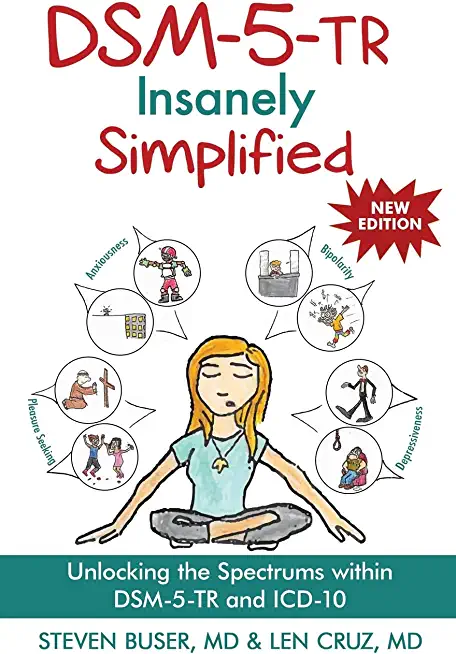
Buser, Steven
DSM-5-TR Insanely Simplified fosters quick mastery of the most important concepts introduced in DSM-5 and continued in DSM-5-TR, while offering an entirely new way of looking at mental health along a continuum. This new approach goes beyond simply "labeling" clients with various diagnoses, but rather places them along spectrums that range from normal to problematic symptoms. Mental health professionals and laypeople will appreciate the synthesis of deep psychology and modern approaches to the diagnosis of mental illness.
Table of Contents
DSM-5-TR Summary Pages
Section I: Overview
1. Introduction
2. History of the DSM
3. What is new in DSM-5-TR
4. What was new in DSM-5
5. The 8 Primary Psychiatric Spectrums of Mental Illness
Section II: The 8 Primary Spectrums of Psychiatry
6. The Depression Spectrum: Shallowness vs. Despair
7. The Mania Spectrum: Boring vs. Bipolar
8. The Anxiety Spectrum: Carelessness vs. Anxiousness
9. The Psychosis Spectrum: Visionless vs. Psychotic
10. The Focus Spectrum: Attention Deficit Disorder vs. Obsessive Compulsive Disorders
11. The Substance Abuse Spectrum: Ascetic vs. Addicted
12. The Autism Spectrum: Codependent vs. Autistic
13. The Personality Spectrum: Neurotic vs. Obnoxious
Section III: The Secondary Areas of Diagnosis
14. The Specialty Areas (Trauma, Neurodevelopmental, Neurocognitive, Behavioral, Dissociative, Somatic, Eating, Elimination, Sleep, Sexual, Gender, Paraphilia)
Section IV: Conclusions
15. The Harmony of the Lotus Flower
16. Carl Jung and his Relationship to DSM-5-TR
Appendix: On ICD-10 and the DSM-5-TR
Endnotes
Index
member goods
listens & views

TORONTO'S MASSIVE FREESTYLE HITS (MOD)
by TORONTO'S MASSIVE FREESTYLE HITS / VARIOUS
COMPACT DISC$13.49






